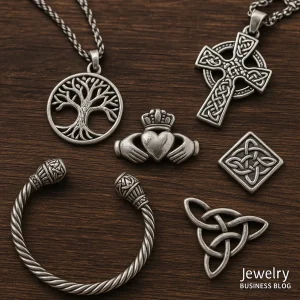Starting a jewelry business can be a rewarding and profitable venture. However, it requires careful planning, creativity, and a solid understanding of the market. This guide will walk you through the essential steps to establish your jewelry business in the USA, with a focus on California’s vibrant market.
Research and Plan Your Business
Market Research
Before launching your jewelry business, it’s crucial to conduct thorough market research. Understand the current trends, customer preferences, and key players in the jewelry industry. Identify your target audience – are you focusing on luxury items, custom pieces, fashion jewelry, or vintage collections?
Business Plan
A well-structured business plan is the foundation of your venture. It should outline your business goals, target market, competitive analysis, marketing strategy, operational plan, and financial projections. Here’s a basic outline:
- Executive Summary: Brief overview of your business.
- Company Description: Details about your business, mission statement, and objectives.
- Market Analysis: Insights into the industry, target market, and competition.
- Organization and Management: Business structure, ownership details, and management team.
- Products and Services: Description of your jewelry line and any additional services.
- Marketing Strategy: How you plan to attract and retain customers.
- Funding Request: If seeking investors or loans, detail your funding requirements.
- Financial Projections: Sales forecasts, income statements, and cash flow projections.
Legal Requirements and Business Structure
Choose a Business Structure
Decide whether you want to operate as a sole proprietorship, partnership, limited liability company (LLC), or corporation. Each structure has its own legal and tax implications.
- Sole Proprietorship: Simplest form, but with personal liability.
- Partnership: Shared responsibility and profits among partners.
- LLC: Offers limited liability protection with flexible tax options.
- Corporation: More complex, with separate legal identity from its owners.
Register Your Business
Register your business with the appropriate state authorities. In California, you will need to file with the California Secretary of State. Obtain an Employer Identification Number (EIN) from the IRS for tax purposes.
Licenses and Permits
Check the local requirements for business licenses and permits. In California, you may need a seller’s permit from the California Department of Tax and Fee Administration (CDTFA) if you plan to sell tangible goods.
Zoning and Location
Ensure your business location complies with local zoning laws. If you plan to operate from home, check if there are any restrictions or requirements.
Setting Up Your Business
Find a Suitable Location
Choose a location that aligns with your target market. High-traffic areas such as shopping districts or upscale neighborhoods can be beneficial. If you’re starting online, invest in a professional e-commerce website.
Create a Brand Identity
Your brand should reflect the quality and style of your jewelry. Develop a unique logo, brand colors, and packaging that resonates with your target audience. Ensure your brand stands out in a competitive market.
Source Materials and Suppliers
Build relationships with reliable suppliers for gemstones, metals, and other materials. Consider ethical sourcing practices, especially if you plan to market your jewelry as sustainable or ethically made.
Design and Production
If you’re a designer, create unique pieces that showcase your talent. Alternatively, you can collaborate with skilled artisans. Ensure high-quality craftsmanship to build a loyal customer base.
Marketing and Selling Your Jewelry
Build an Online Presence
In today’s digital age, having a strong online presence is essential. Develop an e-commerce website with high-quality images and detailed descriptions of your products. Optimize your site for search engines (SEO) to attract organic traffic.
Social Media Marketing
Leverage social media platforms like Instagram, Facebook, and Pinterest to showcase your jewelry. Engage with your audience through regular posts, stories, and promotions. Collaborate with influencers to reach a broader audience.
Offline Marketing
Participate in local events, trade shows, and pop-up markets to promote your jewelry. Establish relationships with local boutiques and retailers to sell your pieces on consignment or wholesale.
Email Marketing
Build an email list of potential and existing customers. Send regular newsletters with updates on new collections, special offers, and events. Personalized email campaigns can boost customer loyalty and repeat sales.
Paid Advertising
Consider investing in paid advertising such as Google Ads or social media ads to drive traffic to your website and increase sales. Target your ads to reach your specific audience demographics.
Financial Management
Startup Costs
Estimate your startup costs, including inventory, equipment, marketing, and operating expenses. Ensure you have sufficient funds to cover these initial costs. Consider applying for small business loans or seeking investors if needed.
Pricing Strategy
Set competitive prices for your jewelry by considering the cost of materials, labor, overhead, and desired profit margins. Research your competitors’ pricing to ensure your prices are aligned with the market.
Bookkeeping and Accounting
Maintain accurate financial records of your income and expenses. Use accounting software to streamline your bookkeeping process. Consider hiring an accountant to manage your finances and ensure compliance with tax regulations.

Customer Service and Growth
Excellent Customer Service
Provide exceptional customer service to build trust and loyalty. Offer hassle-free returns, prompt responses to inquiries, and personalized shopping experiences.
Feedback and Improvement
Regularly seek feedback from your customers and use it to improve your products and services. Stay updated with industry trends and continuously innovate to meet changing customer preferences.
Business Expansion
Once your business is established, consider expanding by introducing new product lines, opening additional locations, or entering new markets. Strategic partnerships and collaborations can also help in scaling your business.
For more insights on establishing a successful jewelry business, check out our detailed guide on Marketing Strategies.
Conclusion
Starting a jewelry business in the USA, particularly in a dynamic market like California, requires careful planning, creativity, and dedication. By following these steps and staying committed to your vision, you can build a successful and thriving jewelry business. Whether you’re designing custom pieces or curating unique collections, your passion and hard work will shine through in your business.
For further details on business setup, visit the California Secretary of State website.






5 Responses